Home University of Edinburgh Library Essentials
July 26, 2024
Last Day for Museums Collections Intern
Posted on August 11, 2017 | in Collections, Interns, Internships, Library & University Collections, Museums | by ahawkinsDuring the summer the Museums Services Team took on a ten week ‘Museums Collections’ intern through the Employ.ed On Campus programme. This is her blog post, reflecting upon ten weeks of work in the Centre for Research Collections.
My name is Jill and I’m an Art History student at the University of Edinburgh, about to enter my fourth and final year of study in September. During the summer I have been interning in the Museum Services department in the Centre for Research Collections, working on a range of different projects, and developing a host of new skills. I started working in the CRC at the beginning of June, and now, ten weeks later, I have come to the end of my internship. I’m feeling quite sad to leave as I have really enjoyed my time here, and I’ve gained some fantastic hands on experience with the University’s fabulous Art Collection. While I have been primarily working with the Art Collection, my work has been varied, so I’ll share a little bit about what I’ve been up to each week.
Week 1
My first week consisted of several meetings with CRC staff, tours of the stores and museums, and getting to grips with the cataloguing software Vernon. These introductory meetings opened my eyes to the broad range of disciplines within the CRC, and allowed me to see how access to the collections is facilitated in a number of different ways. During this week, my line manager Anna taught me how to accession works of art on paper using Vernon. The software seemed daunting at first, but I soon got to grips with it, and by the end of the week I learned how to create and link image files to records. By the end of week 1, I accessioned 55 works of art on paper to the University Art Collection, and developed enough confidence using the software to work independently, while Anna was away on annual leave. Here are two examples of the artworks below.
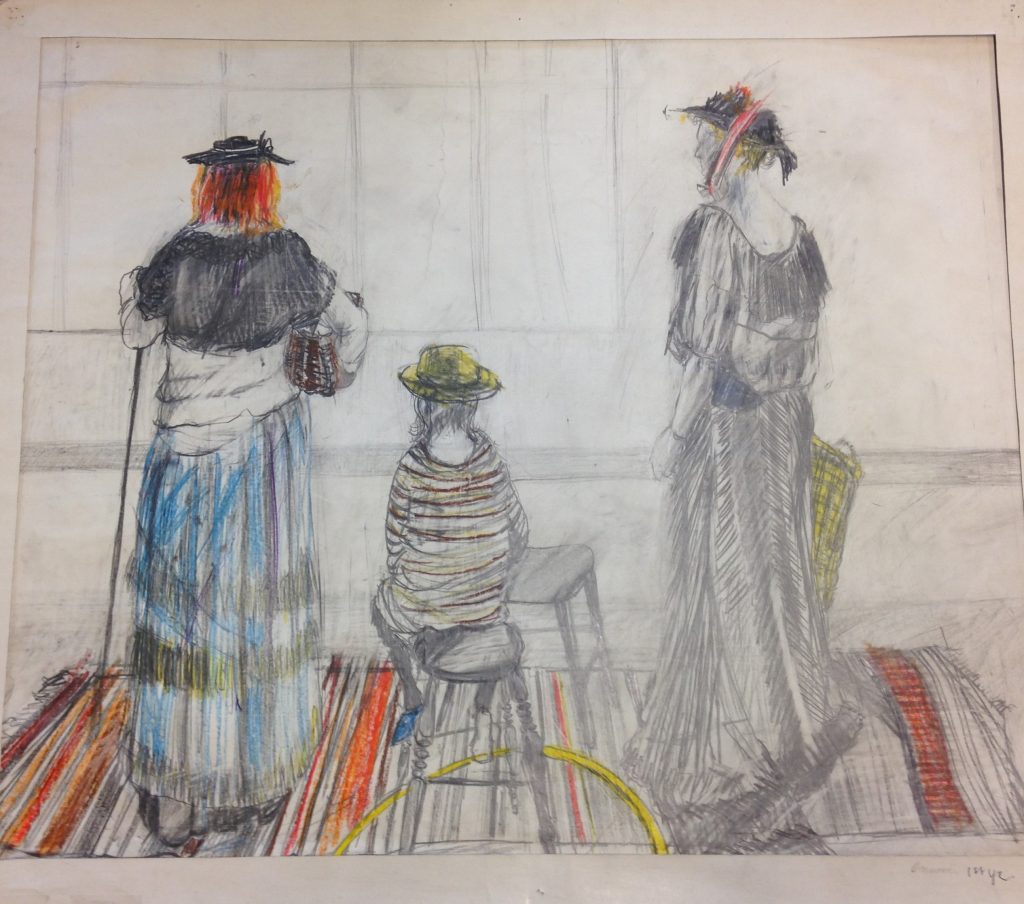
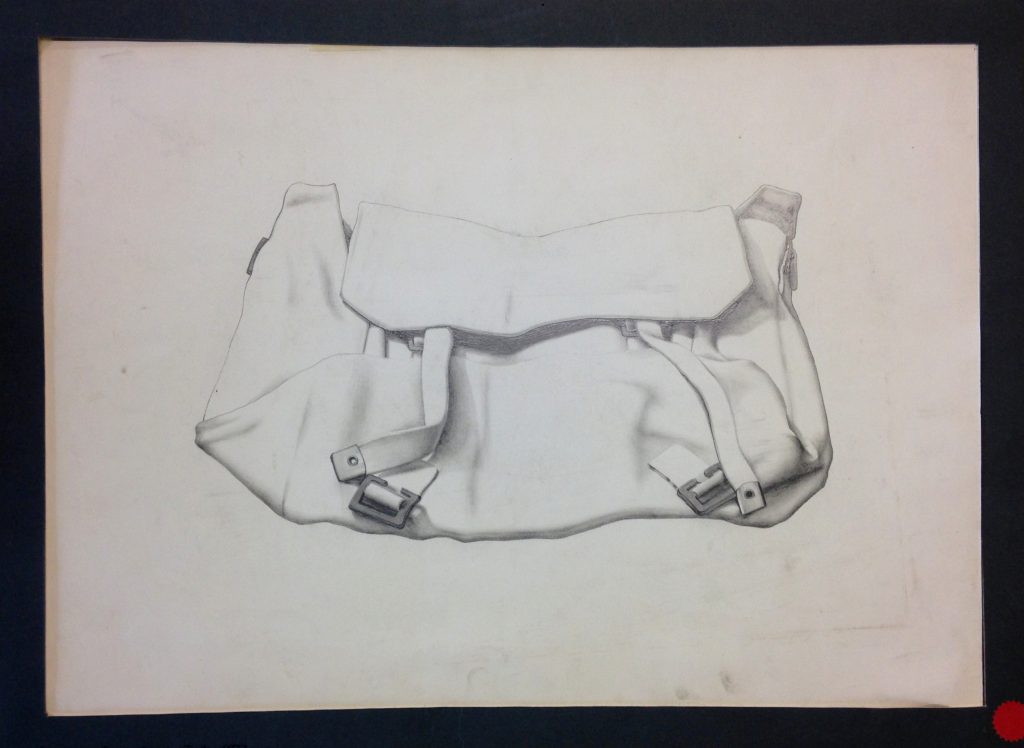
Untitled, Glen M. K. Onwin Untitled, James W. Birrell
Week 2
In weeks 2 and 3 I continued to accession works of art on paper, but also had the opportunity to work in different departments, while Anna was away. This week, I worked in the Anatomy Museum to help another Employ.ed intern, Ellen, with her project, which tackled a large collection of life and death masks from the University’s Phrenological collection. (Read more about Ellen’s project here: https://anatomicalmuseum.wordpress.com/ ) We worked together to unbox busts stored in the Anatomy building’s basement, next door to where anatomy students work with cadavers! Ellen’s manager Ruth taught me how to handle the busts with care, and how best to repack them, with tissue paper and bubble wrap. Over two days, Ellen and I documented and rehoused 23 death masks, allowing Ellen to make a start on her audit of the collection. We also visited the National Portrait Gallery, to look at the masks they have on display, as they still have some busts on loan from our collection.

Ellen inspecting the National Portrait Gallery’s display
Week 3
In week 3, I moved from Anatomy to Conservation, and worked with another intern, Holly, to assist with her project, carrying out preventative conservation on recent donations to the rare book collection. (Read more about Holly’s project here: https://libraryblogs.is.ed.ac.uk/conservation/2017/06/08/new-conservation-internship-at-the-crc/ ) This involved surface cleaning books with vacuum cleaners, using small brush attachments to lift dust from the book’s pages. While surface cleaning the books, Holly taught me how to identify certain types of book damage, including red rot, which is commonly seen on leather bound books. Each time we cleaned a book, we would record it on a spreadsheet, and preform an assessment of its condition. As well as surface cleaning, I learned how to rehouse vulnerable books, by making ‘book shoes.’ These ‘book shoes’ are sturdy covers, made out of non-acidic card, in order to protect paper bound books, or books with loose spines or boards. By the end of the week Holly and I had cleaned approximately 600-800 books, and I made 22 book shoes for rehousing.
Week 4
At the beginning of week 4, my line manager Anna returned from holiday and we began an audit of artworks stored at the Annexe. This involved working closely with Anna to update the location and condition of accessioned works of art, and recording all information about un-accessioned works of art, including a description of style and materials, the artist’s name and date. We were also checking if the artworks have wall fixings, so that they can be hung in a new storage unit, which will be ready next year. Throughout the week I developed confidence in handling small and large scale artworks including paintings, drawings, and mixed media. I also developed skills in identifying damage to works of art, such as buckling paper, historic mould, and paint discolouration. Over the week Anna and I made real progress with the audit, and I also continued accession works of art on paper, adding 40 more to the art collection.
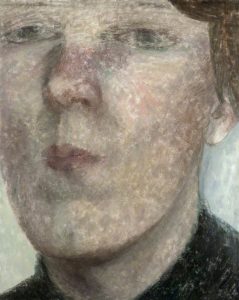
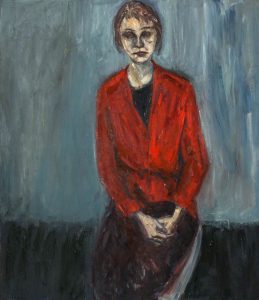
Large Head, Gwen Hardie My Friend Jackie, Claudia Pettriti
Week 5
During week 5 I got my first insight into exhibition management, by working with Kirsty to de-install the previous exhibition in the Main Library Gallery, ‘Sound Body, Sound Mind.’ (Read more about the exhibition here: https://exhibitions.ed.ac.uk/soundbody ) This involved handling rare books, anatomical objects, and a range of musical instruments, to remove them from their bespoke mounts, and repack them for storage. Initially we were both a little uncertain where to begin because neither of us where involved in installing the exhibition, but it was an enjoyable learning experience! As well as developing my skills in object handling and repacking, I gained an insight into how wasteful museum exhibitions tend to be. All of the graphics and decorative details of the exhibition had to be disposed of, and Kirsty worked hard to repurpose some of the details, such as decorative curtains. By the end of the week, the exhibition was completely de-installed and the gallery was prepared as a blank canvas for the next exhibition. During this week I also continued to accession works of art, adding 34 new works to the collection.
Week 6
During week 6 I continued accessioning works of art, and spent some time at the Annexe continuing the audit with Anna. The works of art I handled this week were particularly interesting as they included a range of prints from 2006 and 2007. Some of the prints were from a Norwegian collaborative project with ECA students. The prints demonstrate a range of contemporary printing techniques, many of which I have never seen before. This created some challenges for me, as identifying the printing techniques and materials was difficult, and I was unfamiliar with the technical differences. It was also difficult to record the names of artists and titles of the prints, as much of it was written in Scandinavian languages. By the end of the week I had accessioned 59 works of art on paper, and continued to make progress on the audit at the Annexe.
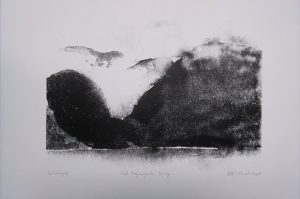
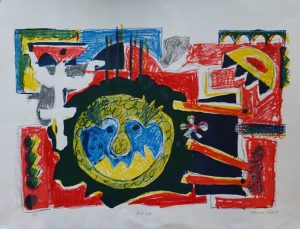
Ved Sognefjorden, Norge, Odd Melseth Pond Life, Alastair Mack
Week 7 + 8
During weeks 7 and 8 I was focused on helping Kirsty install the new exhibition into the Main Library exhibition space. The exhibition, which I hope you have all had the chance to see, is Highlands to Hindustan, an artistically and historically rich exhibition, which celebrates the 70th anniversary of Indian independence. (Read more about the exhibition here: https://exhibitions.ed.ac.uk/highlandstohindustan ) During these two weeks I had the opportunity to gain hands on experience installing a range of different objects, including 2,000 year old Gandharan sculptural fragments, the iconic Maharabatta, and 5th century copper plates. We often worked with gloves, and housed the objects in bespoke mounts, many with clear acrylic bases and discrete metal arms. I also gained training in preventative conservation techniques, including book strapping, which allows books to be held securely open while on display. The task I found most rewarding was the installation of two long, thin, fragile scrolls, illuminated manuscripts that are over 200 years old. This was a very delicate job and we worked without gloves to give us maximum dexterity. The scrolls unravelled and stayed in place much easier than I imagined, and we secured them with transparent melinex slips. By the end of week 8, the exhibition was ready, and the opening night was a great success!
Week 9 + 10
During the last two weeks, I have continued to accession works of art on paper to the art collection, continued the audit at the Annexe, and helped Kirsty with another exhibition installation. Last week I helped Kirsty to install the new exhibition in the 6th floor reception area, which celebrates the 50th anniversary of the Main Library. (Read more about the anniversary here: http://www.ed.ac.uk/edit-magazine/editions/issue-4/landmark ) This involved arranging photographs, and an old Apple Mac computer. The photos are really interesting, so I would definitely recommend a visit! Last week I accessioned 29 works of art, and we almost finished our audit at the Annexe. In total, I have added 270 works of art to the University’s Art Collection, de-installed, and installed 2 exhibitions, and assisted with projects in the anatomy and conservation departments.
Conclusion
I have really enjoyed my time working in the CRC this summer, and have really benefited from the varied nature of my internship. I’m very grateful to everyone who has worked with me over the past ten weeks, and to everyone who has let me work on their projects! I would encourage everyone to visit the exhibitions currently on display in the Main Library, and to explore the University’s collections online. There really is hidden treasure to find!
Collections
 Archival Provenance Project: Emily’s finds
My name is Emily, and I’m the second of the two archive interns that...
Archival Provenance Project: Emily’s finds
My name is Emily, and I’m the second of the two archive interns that...
 Archival Provenance Project: a glimpse into the university’s history through some of its oldest manuscripts
My name is Madeleine Reynolds, a fourth year PhD candidate in History of Art....
Archival Provenance Project: a glimpse into the university’s history through some of its oldest manuscripts
My name is Madeleine Reynolds, a fourth year PhD candidate in History of Art....
Projects
 Sustainable Exhibition Making: Recyclable Book Cradles
In this post, our Technician, Robyn Rogers, discusses the recyclable book cradles she has developed...
Sustainable Exhibition Making: Recyclable Book Cradles
In this post, our Technician, Robyn Rogers, discusses the recyclable book cradles she has developed...
 Giving Decorated Paper a Home … Rehousing Books and Paper Bindings
In the first post of this two part series, our Collection Care Technician, Robyn Rogers,...
Giving Decorated Paper a Home … Rehousing Books and Paper Bindings
In the first post of this two part series, our Collection Care Technician, Robyn Rogers,...
